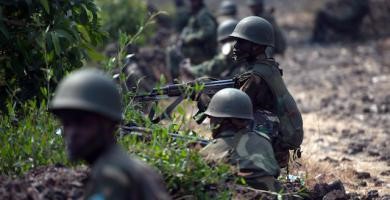 Persistent insecurity in North Kivu province in the Democratic Republic of the Congo, even after the deployment of peacekeeping forces, has sent the United Nations looking for new solutions. In order to extend the reach and intelligence-gathering capabilities of peacekeepers in eastern Congo, the United Nations has decided to deploy unmanned aerial vehicles to the area. The topography of eastern Congo will in some respects limit the effectiveness of the unmanned aerial vehicles, colloquially known as drones, but they could still expand the range of and intelligence available to U.N. forces in the area.
Persistent insecurity in North Kivu province in the Democratic Republic of the Congo, even after the deployment of peacekeeping forces, has sent the United Nations looking for new solutions. In order to extend the reach and intelligence-gathering capabilities of peacekeepers in eastern Congo, the United Nations has decided to deploy unmanned aerial vehicles to the area. The topography of eastern Congo will in some respects limit the effectiveness of the unmanned aerial vehicles, colloquially known as drones, but they could still expand the range of and intelligence available to U.N. forces in the area.
The U.N. Department for Peacekeeping Operations signed a contract July 12 with an unspecified company to provide drones to the peacekeeping operation in the Congo as part of a trial phase. No details were given on the type of drones selected except that they would be unarmed. They could range from small, hand-launched vehicles to larger drones with longer loitering times and heavier, more advanced sensor packages.
Drones have been successfully deployed in several parts of Africa, most notably in Somalia and Mali. However, the geography of those regions differs greatly from that in the eastern Congolese province of North Kivu. Dense vegetation blankets the hills of North Kivu, where numerous rebel groups thrive and withstand the limited military power of the central government in Kinshasa.
The canopy of this vegetation shields the ground from visual sensors and severely restricts the effectiveness of thermal imaging sensors such as forward-looking infrared optics. The leaves that make up this thick canopy are filled with water, which retains heat. The canopy also traps warm air below, lowering the temperature contrast between targets and the background while also distorting infrared radiation when it passes through the vegetation. Other factors, such as local humidity, can also disperse radiation in the atmosphere, while precipitation frequently covers everything in a thin layer of water, further reducing the thermal contrast.
Visual and thermal sensors may still prove useful in less overgrown areas, but more important, other drone sensors could be more effective. For example, signals intelligence sensors could enable U.N. forces to locate and tap into rebel communications. Electronic intelligence sensors could be used to track non-signal electronic emissions from rebels in this terrain, where little electronic clutter is present. These types of sensors could improve intelligence collection compared to using only the visual and thermal sensors. There are also some radar bands that can effectively penetrate jungle canopy. Thus, the utility of the drones will heavily depend on the type of vehicle and its sensor packages.
In recent years, drones have been deployed in similar terrain, especially at wildlife reserves in attempts to curb poaching. The South African Seeker II drone, produced by South African aerospace and defense company Denel, has been used in this role, but it depended mostly on infrared sensors to spot targets in the open at night. The operation of drones against eastern Congolese rebels would require more extensive capabilities than those needed in limited anti-poaching missions.
Recently, the U.N. Security Council delivered a mandate for the deployment of an offensive intervention brigade in Kivu. The force is currently being set up in the provincial capital, Goma. The deployment of drones may act as a force multiplier to the operations of this brigade, the relatively small size of which limits its reach.
The drones could also help in another respect. The transport of peacekeepers in North Kivu is severely constrained by nonexistent or poor quality roads. Congolese rebels are much more likely to travel extended distances by foot, something U.N. peacekeepers cannot safely do. The deployment of drones can help address this asymmetry.
It is unclear whether the drones will be deployed in direct coordination with the intervention brigade or whether their deployment will be kept on a separate track. Either way, the presence of drones, depending on the type deployed, could give the peacekeepers increased intelligence coverage of terrain that is currently too perilous to move personnel through. It could also provide better information on the activities of rebels in border areas with Uganda and Rwanda.
Courtesy : Stratfor (www.stratfor.com)